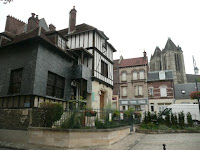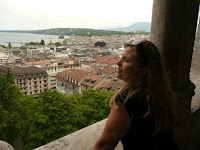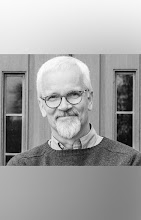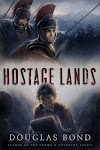 I feel like I haven't given Notre Dame, Noyon, the cathedral that is a stone toss from Calvin's birthplace (and across from our hotel), where his father worked for the bishop, Charles Hangest, and where it is
I feel like I haven't given Notre Dame, Noyon, the cathedral that is a stone toss from Calvin's birthplace (and across from our hotel), where his father worked for the bishop, Charles Hangest, and where it is  inconcievable to imagine that Calvin did not know every nook and cranny as a boy, fair representation. It is a marvelous 12th century gothic masterpiece as you can see from these images, and Calvin would have known this place intimately as a boy. I've pasted in some descriptions of it from The Betrayal, chapter 4 below. Picture Calvin at 12-years old receiving his first benefice in this place.
inconcievable to imagine that Calvin did not know every nook and cranny as a boy, fair representation. It is a marvelous 12th century gothic masterpiece as you can see from these images, and Calvin would have known this place intimately as a boy. I've pasted in some descriptions of it from The Betrayal, chapter 4 below. Picture Calvin at 12-years old receiving his first benefice in this place.An event transpired of great significance on May 21, 1521. I was there. The smoky sweetness of incense drifted like wisps of lingering spirits from the chancel of our cathedral church in Noyon-le-Sainte. In my youth, as is the way of youth, I appreciated little about that great edifice. To me, then it was merely a stout old building made of shabby old stones, wherein candles flickered and lecherous old men and tender boy choristers paraded about, chanting the gloomy Miserere.

I have since learned that our cathedral of Notre Dame, as I then knew it, was rebuilt after the great fire of 1131, coming to its completion, I’m told, nearly one hundred years later. Pilgrims from time to time would pass through out town to venerate the alleged relics of St.
 Eloi, 7th century goldsmith turned bishop of Noyon, patron saint of workers in precious metals. I thought goldsmithing a fitting avocation for a bishop. Inexplicably, St. Eloi was taken up as the patron of blacksmiths, and adding another layer of mystification, local horse breeders in Picardy still swear...
Eloi, 7th century goldsmith turned bishop of Noyon, patron saint of workers in precious metals. I thought goldsmithing a fitting avocation for a bishop. Inexplicably, St. Eloi was taken up as the patron of blacksmiths, and adding another layer of mystification, local horse breeders in Picardy still swear...... For I knew that the chaplain of La Gesine had only just resigned his post and that the bishop was sure to confer the vacant chaplaincy upon the young scholar.
Yet did I despise him still more for what it all meant. He was being marked out for priesthood, and more to the point, for a handsome income, one that would now fill the purse of the favored young man—further setting him above me and my station, and further embittering my heart against him.

I had seen enough. Soundlessly I turned my back and left the cathedral, the chanting of the bishop fading as I went. From the eminence of the cathedral’s situation, I surveyed the tile roofs of Noyon, fanning out, like my life, in a disordered and seemingly random jumble.
Surrounding the tile roofs of the half-timbered, clustered houses lay wooded hills of beech and oak. For all its un-remarkableness then to me, Noyon is an appealing town with a long histo
 ry. Since the Romans subjugated the Gauls, the fertile plain on which it rests, watered by the Verses and Oise Rivers, has been home to untold generations of craftsmen, farmers, bakers, butchers, tanners—like my family—horse breeders, nobles, and of course the clergy.
ry. Since the Romans subjugated the Gauls, the fertile plain on which it rests, watered by the Verses and Oise Rivers, has been home to untold generations of craftsmen, farmers, bakers, butchers, tanners—like my family—horse breeders, nobles, and of course the clergy.I mused on the infinite variety of human existence represented by that tumbling array of individual houses connected by the narrow cobbled streets that we called our village. It had been called that by many before my generation, and was like to by called so by many more, so I then thought.
As I stood considering the array of life that stretched downhill before me, the boy choristers
 must have ascended to the heights of polyphonic grandeur with the Ave Maria, ora pro nobis, for they succeeded, aided by the deep-toned organ, in pulling my attention back up the hill to the cathedral.
must have ascended to the heights of polyphonic grandeur with the Ave Maria, ora pro nobis, for they succeeded, aided by the deep-toned organ, in pulling my attention back up the hill to the cathedral.It was the only cathedral I knew, but since then I have seen many. Ours was of the sturdier sort. Heavy, boxy towers that ca
 st their wide shadow across the red-brown roofs on sunny afternoons, stood square and unyielding, as if guarding the west entrance with twin might against heretics and infidels.
st their wide shadow across the red-brown roofs on sunny afternoons, stood square and unyielding, as if guarding the west entrance with twin might against heretics and infidels.I now believe the east-end of Notre Dame Cathedral Noyon to be one of the most grand of all. Its magnificent flying buttresses flange out in three broad terraces holding the bishop’s seat immovably in its place. I wondered at such grand old churches, built, it would seem, so to impress the viewer as to make them unshakably committed to the lesser visible dimensions of religion...


























.JPG)













































